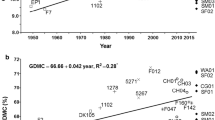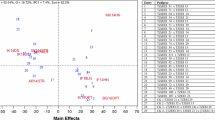Summary
The gene pool available for maize breeding is restricted. The heterosis sources used successfully over the last 80 years (Lancaster, Reid Yellow Dent) have been over-exploited and are near exhaustion (Duvick and Cassman 1999). Among the European sources of heterosis, European Flint is widely known, but its earliness and special suitability for silage maize breeding do not allow it to make any great contribution to further improvements in the yield potential of mid-season or late-maturing maize hybrids.
In addition to developing new heterosis sources, the utilisation of older but little known sources could be a useful way of supplementing widely used sources. Over the last 50–60 years at least 29 inbred lines with commercial value have been developed from the Rumai group of the Central European Dent race and at least 19 from Mindszentpusztai Yellow Dent. Lines of Rumai and Mindszentpusztai Yellow Dent are at least as important in the European Corn Belt as lines originating from Lancaster Surecrop and Reid Yellow Dent are in the North American Corn Belt. In addition the first maize hybrid registered in Europe, Mv 5, was developed in Hungary, was a double cross involving three MYD lines. The paper provides a review of the contribution made by Mindszentpusztai Yellow Dent to Hungarian hybrid maize breeding during a period of over 50 years.
Similar content being viewed by others
References
Balogh, J. (1988): A kukorica fajtaszerkezete Magyarorszagon 1938–1987. között. (Maize varieties available in Hungary 1938–1987.) Gabonamag Alapanyagszaporító Gazdasági Társaság. Budapest 77 p.
Brunklaus-Jung, E., Ludwig, W. F., Boppenmaier, J., Melchinger, A. E., Herrmann, R.G. (1993): RFLP analyses of early maturing European maize germplasm: II. Correlation between RFLP and pedigree data. Maydica 38. 239–244.
Darrah, L. L., Zuber, M. S. (1985): 1985 United States farm maize germplasm base and commercial breeding strategies. Crop. Sci. 26. 1109–1113.
Dubreuil, P., Dufour, P., Krajci, E., Causee, M., de Vienne, D., Gallais, A., Charcosset, A. (1996): Organization of RFLP diversity among inbred lines of maize representing the most significant heterotic groups. Crop Sci. 36. 790–799.
Dudley, J. W., Saghai Maroof, M. A., Rufener, G. K. (1991): Molecular markers and grouping of parents in maize breeding programs. Crop. Sci. 31. 719–723.
Duvick, D. N. (1984): Genetic diversity in major farm crops on the farm and in reserve. Economic Botany. 38. (2) pp. 161–178.
Duvick, D. N., Cassman, K. G. (1999): Post-green revolution trends in yield potential of temperate maize in the North-Central United States. Crop Sci. 39. 1622–1630.
Fleischmann, R. (1913a): A rumai uradalom tengeri nemesitő eljárása. (Maize breeding method followed on the Ruma estate.) Köztelek 23. 1694–1697.
Fleischmann, R. (1913b): A tengericső alakulásának jelentősége a tengeri nemesítésénél. (Importance of ear formation in maize breeding.) Köztelek 23. 3012–3013.
Fleischmann, R. (1914): A rumai uradalom kukoricája. (The maize developed on the Ruma estate.) Gazdasági Lapok 66. 345–346.
Fleischmann, R. (1916): A nemesitett tengeri fajták kipróbálása és a tengeri nemesitése. (Testing of improved maize varieties and the breeding of maize.) Köztelek 26. 585–586.
Fleischmann, R. (1920): Kukoricaterméseink fokozâsa fajtanemesités útján. (Improvements in maize yields by variety breeding.) Köztelek 30. 753–754.
Fleischmann, R. (1934): Az „F” kukorica termoképességének kialakulâsa nemesités útján. (Trends in the yield potential of “F” maize as the result of breeding.) Köztelek 44. 400–401.
Fleischmann, R. (1939): Az „F” kukorica újabb fejlődése. (Recent improvements in “F” maize.) Köztelek 49. 264–265.
Frei, O. M. (2000): Changes in yield physiology of corn as a result of breeding in Northern Europe. Maydica 45. 173–183.
Hadi, G. (2003a): Contribution of population improvement to the development of maize lines with commercial value. Acta Agronomica Hungarica 51. 11–17.
Hadi, G. (2003b): Role of open-pollinated populations in the development of maize lines with commercial value. Acta Agronomica Hungarica 51. 229–235.
Hallauer, A. R., Miranda, FO. I. B. (1981): Quantitative Genetics in Maize Breeding. Iowa State University Press. Ames.
Hegedüs, B. A. (1996): Építeni szórakoztatóbb, mint nem építeni. Pap Endre az első európai hibridkukorica nemesitője elmondja életét. (To build is more fun than not to build. Endre Pap, breeder of Europe’s first maize hybrid, recounts his life.) MTA Mg.Kut. Int. Martonvásár.
Jánossy, A., Komlóssy, G., Mórász, S., Taróczi, H. (1957): Magyar kukoricafajtáak és termesztésük. (Hungarian maize varieties and their cultivation.) Mezőgazdasági Kiadó, Budapest, pp. 5–72.
Kovács, I. (1970): Selection and evaluation of basic material for breeding. In: Koväcs. I. (ed.), Some Methodological Achievements of the Hungarian Hybrid Maize Breeding. Akadémiai Kiadó, Budapest, pp. 23–64.
Kovarski, A. E., Utshkovski, V. G., Tshalik, T. S., Borovski, M. I. (1965): Perspektivnie kishinevskie gibridi kukuruzi. (Promising maize hybrids from Kishinev.) In: Kovarski. A. E. (ed.), Genetika, selektsia i zamenovodstvo kukuruzi. Izd. Karta Moldovenskaia, Kishinev, pp. 3–41.
Melchinger, A. E., Messmer, M. M., Lee, M., Woodman, W. L., Lamkey, K. R. (1991): Diversity and relationships among U.S. maize inbreds revealed by restriction fragment length polymorphisms. Crop. Sci. 31. 669–677.
Messmer, M. M., Melchinger, A. E., Hessmann, R. G., Boppenmaier, J. (1993): Comparison of pedigree and RFLP data. Crop Sci. 33. 944–950.
Messmer, M. M., Melchinger, A. E., Lee, M., Woodman, W. L., Lee, A. E., Lamkey, K. R. (1991): Genetic diversity among progenitors and elite lines from the Iowa Stiff Stalk Synthetic (BSSS) maize population: Comparison of allozyme and RFLP data. Theor. Appl. Genet. 83. 97–107.
Misevic, D. (1989a): Heterotic patterns among U.S. Corn Belt. Yugoslavian and exotic maize populations. Maydica 34. 353–363.
Misevic, D. (1989b): Evaluation of three test statistics used to identify maize inbred lines with new favorable alleles not present in elite single cross. Theor. Appl. Genet. 77. 402–408.
Misevic, D. (1989c): Identification of inbred lines as a source of new alleles for improvement of elite maize single crosses. Crop Sci. 29. 1120–1125.
Misevic, D. (1990): Evaluation of commercial maize hybrids as sources of new favorable alleles. Maydica 35. 287–295.
Mumm, R. H., Dudley, J. W. (1994): A classification of 148 U.S. maize inbreds: I. Cluster analysis based on RFLPs. Crop Sci. 34. 842–851.
Mumm, R. H., Hubert, L. J., Dudley, J. W. (1994): A classification of 148 U.S. maize inbreds: II. Validitation of cluster analysis based on RFLPs. Crop Sci. 34. 852–865.
Radovic, G., Jelovac, D. (1995): Identification of the heterotic pattern in Yugoslav maize germplasm. Maydica 40. 223–227.
Smith, J. S. C, Goodman, M. M., Stuber, C. W. (1985a): Genetic variability within U.S. maize germplasm. I. Historically important lines. Crop Sci. 25. 550–555.
Smith, J. S. C, Goodman, M. M., Stuber, C. W. (1985b): Genetic variability within U.S. maize germplasm. II. Widely-used inbred lines 1970 to 1979. Crop Sci. 25. 681–685.
Smith, J. S. C, Smith, O. S. (1989): The description and assessment of distances between inbred lines of maize: II. The utility of morphological, biochemical, and genetic descriptors and scheme for the testing of distinctiveness between inbred lines. Maydica. 34. 151–161.
Smith, J. S. C, Smith, O. S. (1991): Restriction fragment length polymorphisms can differentiate among U.S. maize hybrids. Crop. Sci. 31. 893–899.
Smith, J. S. C, Smith, O. S., Bowen, S. L., Tenborg, R. A., Wall, S. J. (1991): The description and assessment of distances between inbred lines of maize. III. Revised scheme for the testing of distinctiveness between inbred lines utilizing DNA RFLPs. Maydica. 36. 213–226.
Surânyi, J. (1938): Három évi kísérletek kukoricafajtákkal 1934–1936. (Three years of experiments on maize varieties 1934–1936.) Országos M. Kir. Növénytermesztési Kisérleti Állomás Jelentései. Magyaróvár. 4 (1). 1-199.
Taróczi, H. (1952): Kukorica. (Maize.) In: Jánossy. A. (ed.), Nemesitett növényfajtákkal végzett országos fajtakísérletek eredményei 1951. Mezőgazdasági Kiadó, Budapest, pp. 91–117.
Troyer, A. F. (1990): A retrospective view of corn genetic resources. Journ. of Hered. 81. (1) 17–24.
Troyer, A. F. (1999): Background of U.S. hybrid corn. Crop Sci. 39. 601–626.
Villax, Ö., Surányi, J. (1932): Maissorten in Ungarn. (Varieties of corn in Hungary.) Magyaróvár. pp. 1–64.
Williams, T. R., Hallauer, A. F. (2000): Genetic diversity among maize hybrids. Maydica 45. 163–171.
Zuber, M. S., Darrah, L. L. (1980): 1979 U.S. corn germplasm base. Annu. Corn and Sorghum Ind. Res. Conf., 35. 234–249.
Author information
Authors and Affiliations
Rights and permissions
About this article
Cite this article
Hadi, G., Marton, L.C., Szundy, T. et al. Contribution made by the maize variety Mindszentpusztai Yellow Dent (MYD) to the birth of hybrid maize in Hungary and in Europe as a whole Review. CEREAL RESEARCH COMMUNICATIONS 32, 159–166 (2004). https://doi.org/10.1007/BF03543294
Received:
Accepted:
Published:
Issue Date:
DOI: https://doi.org/10.1007/BF03543294




